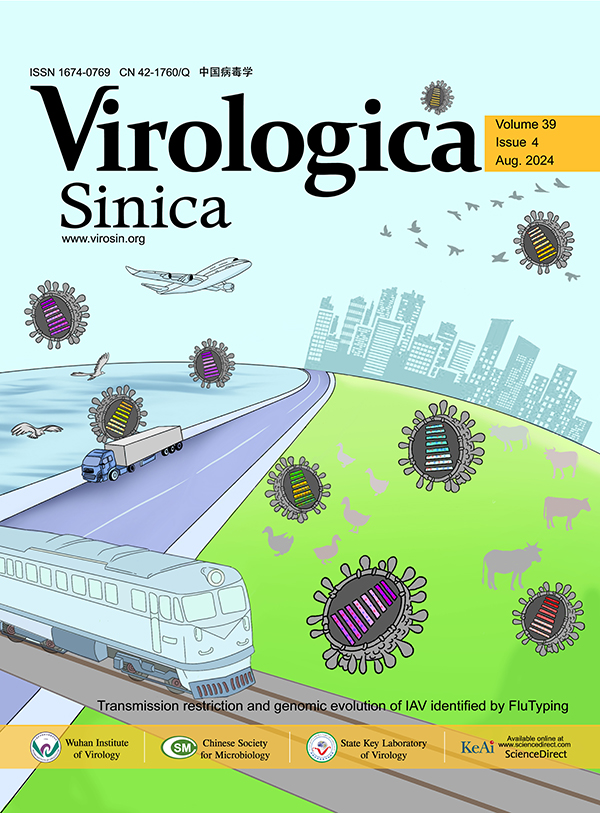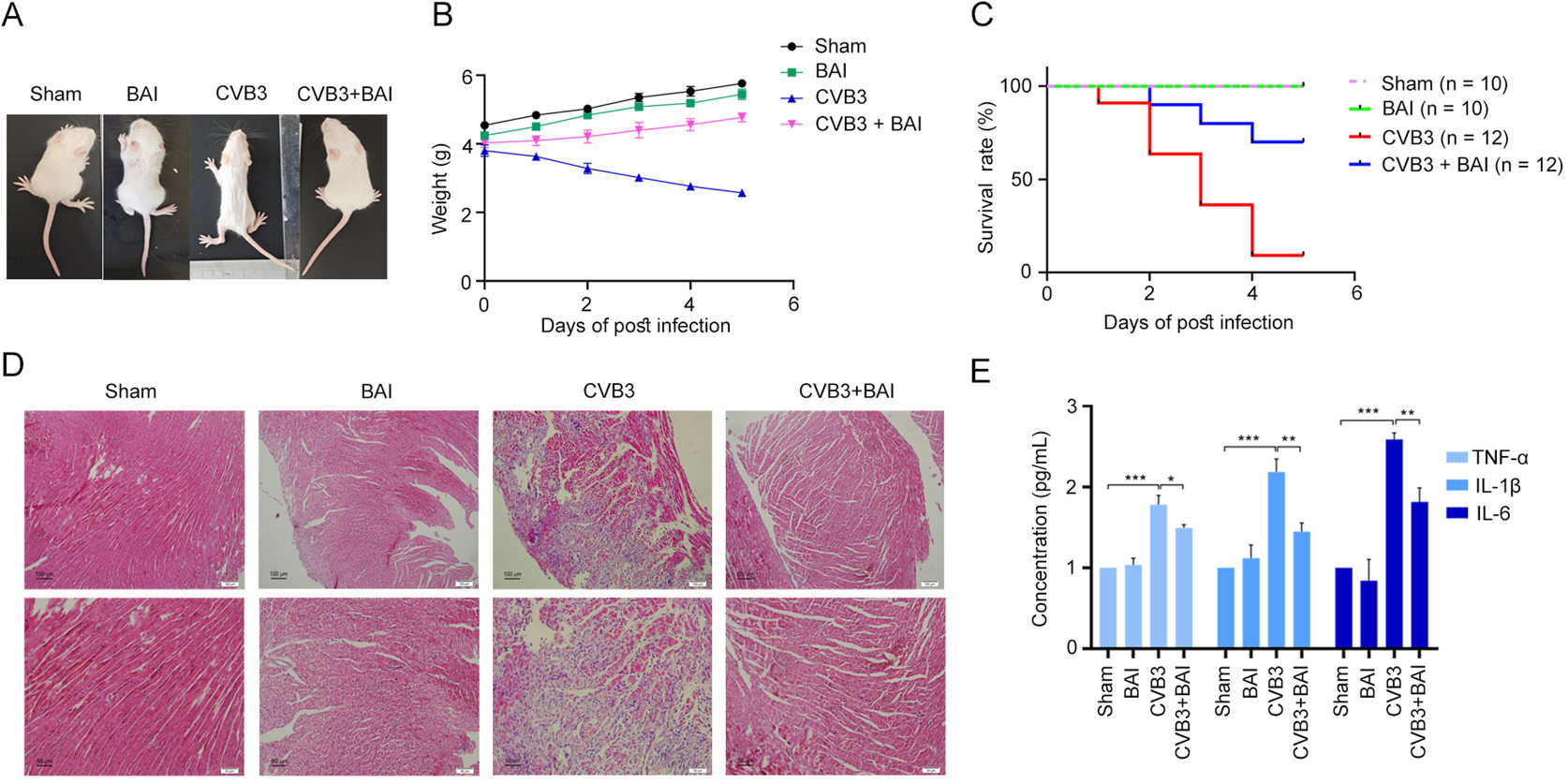-
Akao T, Kawabata K, Yanagisawa E, Ishihara K, Mizuhara Y, Wakui Y, Sakashita Y, Kobashi K. 2000. Baicalin, the predominant flavone glucuronide of scutellariae radix, is absorbed from the rat gastrointestinal tract as the aglycone and restored to its original form. J. Pharm. Pharmacol. 52: 1563-1568.
-
Anirudhan V, Lee H, Cheng H, Cooper L, Rong L. 2021. Targeting SARS-CoV-2 viral proteases as a therapeutic strategy to treat COVID-19. J. Med. Virol. 93: 2722-2734.
-
Baggen J, Thibaut HJ, Strating JRPM, van Kuppeveld FJM. The life cycle of non-polio enteroviruses and how to target it. Nat. Rev. Microbiol. 2018; 16: 368-381.
-
Bergelson JM, Cunningham JA, Droguett G, Kurt-Jones EA, Krithivas A, Hong JS, Horwitz MS, Crowell RL, Finberg RW. 1997. Isolation of a common receptor for Coxsackie B viruses and adenoviruses 2 and 5. Science 275: 1320-1323.
-
Bonderoff JM, Lloyd RE. 2008. CVB translation: lessons from the polioviruses. Curr. Top. Microbiol. Immunol. 323: 123-147.
-
Bopegamage S, Berakova K, Gomocak P, Baksova R, Galama J, Hyoty H, Tauriainen S. 2021. Primary site of Coxsackievirus B replication in the small intestines: no proof of Peyer's patches involvement. Microorganisms. 9: 2600.
-
Chagas MDSS, Behrens MD, Moragas-Tellis CJ, Penedo GXM, Silva AR, Goncalves-de-Albuquerque CF. 2022. Flavonols and flavones as potential anti-inflammatory, antioxidant, and antibacterial compounds. Oxid. Med. Cell. Longev. 2022: 9966750.
-
Chau DH, Yuan J, Zhang H, Cheung P, Lim T, Liu Z, Sall A, Yang D. 2007. Coxsackievirus B3 proteases 2A and 3C induce apoptotic cell death through mitochondrial injury and cleavage of eIF4GI but not DAP5/p97/NAT1. Apoptosis. 12: 513-524.
-
Chung M, Andreoletti L, N'Guyen Y, Soize S, Bani-Sadr F, Hentzien M. 2022. Acute Coxsackievirus B3-induced meningo-cerebellitis in an immunocompetent adult patient. J. Neurovirol. 28: 619-621.
-
Diep J, Ooi YS, Wilkinson AW, Peters CE, Foy E, Johnson JR, Zengel J, Ding S, Weng KF, Laufman O, Jang G, Xu J, Young T, Verschueren E, Kobluk KJ, Elias JE, Sarnow P, Greenberg HB, Huttenhain R, Nagamine CM, Andino R, Krogan NJ, Gozani O, Carette JE. 2019. Enterovirus pathogenesis requires the host methyltransferase SETD3. Nat. Microbiol. 4: 2523-2537.
-
Gaaloul I, Riabi S, Harrath R, Hunter T, Hamda KB, Ghzala AB, Huber S, Aouni M. 2014. Coxsackievirus B detection in cases of myocarditis, myopericarditis, pericarditis and dilated cardiomyopathy in hospitalized patients. Mol. Med. Rep. 10: 2811-2818.
-
Garmaroudi FS, Marchant D, Hendry R, Luo H, Yang D, Ye X, Shi J, McManus BM. 2015. Coxsackievirus B3 replication and pathogenesis. Future Microbiol. 10: 629-653.
-
Gazina EV, Smidansky ED, Holien JK, Harrison DN, Cromer BA, Arnold JJ, Parker MW, Cameron CE, Petrou S. 2011. Amiloride is a competitive inhibitor of coxsackievirus B3 RNA polymerase. J. Virol. 85: 10364-10374.
-
Han Z, Zhang Y, Huang K, Wang J, Tian H, Song Y, Yang Q, Yan D, Zhu S, Yao M, Wang X, Xu W. 2019. Two Coxsackievirus B3 outbreaks associated with hand, foot, and mouth disease in China and the evolutionary history worldwide. BMC Infect. Dis. 19: 466.
-
He Y, Chipman PR, Howitt J, Bator CM, Whitt MA, Baker TS, Kuhn RJ, Anderson CW, Freimuth P, Rossmann MG. 2001. Interaction of coxsackievirus B3 with the full length coxsackievirus-adenovirus receptor. Nat. Struct. Biol. 8: 874-878.
-
Kemball CC, Alirezaei M, Whitton JL. 2010. Type B coxsackieviruses and their interactions with the innate and adaptive immune systems. Future Microbiol. 5: 1329-1347.
-
Kim BK, Cho JH, Jeong P, Lee Y, Lim JJ, Park KR, Eom SH, Kim YC. 2015. Benserazide, the first allosteric inhibitor of Coxsackievirus B3 3C protease. FEBS Lett. 589: 1795-1801.
-
Laitinen OH, Svedin E, Kapell S, Nurminen A, Hytonen VP, Flodstrom-Tullberg M. 2016. Enteroviral proteases: structure, host interactions and pathogenicity. Rev. Med. Virol. 26: 251-267.
-
Liang W, Huang X, Chen W. 2017. The effects of baicalin and baicalein on cerebral ischemia: a review. Aging Dis. 8: 850-867.
-
Liao H, Ye J, Gao L, Liu Y. 2021. The main bioactive compounds of Scutellaria baicalensis Georgi. for alleviation of inflammatory cytokines: a comprehensive review. Biomed. Pharmacother. 133: 110917.
-
Liu Y, Chen J, Zhang M, Guo W, Feng C, Liu J, Xu L, Gao N, Ma S. 2023. Coxsackievirus B: the important agent of hand, foot, and mouth disease. J. Med. Virol. 95: e28669.
-
Lopacinski AB, Sweatt AJ, Smolko CM, Gray-Gaillard E, Borgman CA, Shah M, Janes KA. 2021. Modeling the complete kinetics of coxsackievirus B3 reveals human determinants of host-cell feedback. Cell Syst. 12: 304-323.e13.
-
Miao EA, Rajan JV, Aderem A. 2011. Caspase-1-induced pyroptotic cell death. Immunol. Rev. 243: 206-214.
-
Ming J, Zhuoneng L, Guangxun Z. 2018. Protective role of flavonoid baicalin from Scutellaria baicalensis in periodontal disease pathogenesis: a literature review. Complement. Ther. Med. 38: 11-18.
-
Moghaddam E, Teoh BT, Sam SS, Lani R, Hassandarvish P, Chik Z, Yueh A, Abubakar S, Zandi K. 2014. Baicalin, a metabolite of baicalein with antiviral activity against dengue virus. Sci. Rep. 4: 5452.
-
Muckelbauer JK, Kremer M, Minor I, Diana G, Dutko FJ, Groarke J, Pevear DC, Rossmann MG. 1995. The structure of coxsackievirus B3 at 3.5 A resolution. Structure. 3: 653-667.
-
Mukherjee A, Morosky SA, Delorme-Axford E, Dybdahl-Sissoko N, Oberste MS, Wang T, Coyne CB. 2011. The coxsackievirus B 3C protease cleaves MAVS and TRIF to attenuate host type I interferon and apoptotic signaling. PLoS Pathog. 7: e1001311.
-
Nekoua MP, Alidjinou EK, Hober D. 2022. Persistent coxsackievirus B infection and pathogenesis of type 1 diabetes mellitus. Nat. Rev. Endocrinol. 18: 503-516.
-
Oo A, Teoh BT, Sam SS, Bakar SA, Zandi K. 2019. Baicalein and baicalin as Zika virus inhibitors. Arch. Virol. 164: 585-593.
-
Organtini LJ, Makhov AM, Conway JF, Hafenstein S, Carson SD. 2014. Kinetic and structural analysis of coxsackievirus B3 receptor interactions and formation of the A-particle. J. Virol. 88: 5755-5765.
-
Palmenberg AC. 1987. Picornaviral processing: some new ideas. J. Cell. Biochem. 33: 191-198.
-
Rui W, Li S, Xiao H, Xiao M, Shi J. 2020. Baicalein attenuates neuroinflammation by inhibiting NLRP3/caspase-1/GSDMD pathway in MPTP induced mice model of Parkinson's disease. Int. J. Neuropsychopharmacol. 23: 762-773.
-
Shen YC, Chiou WF, Chou YC, Chen CF. 2003. Mechanisms in mediating the anti-inflammatory effects of baicalin and baicalein in human leukocytes. Eur. J. Pharmacol. 465: 171-181.
-
Smyth MS, Martin JH. 2002. Picornavirus uncoating. Mol. Pathol. 55: 214-219.
-
Song J, Zhang L, Xu Y, Yang D, Zhang L, Yang S, Zhang W, Wang J, Tian S, Yang S, Yuan T, Liu A, Lv Q, Li F, Liu H, Hou B, Peng X, Lu Y, Du G. 2021. The comprehensive study on the therapeutic effects of baicalein for the treatment of COVID-19 in vivo and in vitro. Biochem. Pharmacol. 183: 114302.
-
Stone VM, Ringqvist EE, Larsson PG, Domsgen E, Holmlund U, Sverremark-Ekstrom E, Flodstrom-Tullberg M. 2021. Inhibition of type III interferon expression in intestinal epithelial cells-a strategy used by Coxsackie B virus to evade the host's innate immune response at the primary site of infection? Microorganisms. 9: 105.
-
Tao Z, Song Y, Li Y, Liu Y, Jiang P, Lin X, Liu G, Song L, Wang H, Xu A. 2012. Coxsackievirus B3, Shandong Province, China, 1990-2010. Emerg. Infect. Dis. 18: 1865-1867.
-
Tapparel C, Siegrist F, Petty TJ, Kaiser L. 2013. Picornavirus and enterovirus diversity with associated human diseases. Infect. Genet. Evol. 14: 282-293.
-
Tu Z, Chapman NM, Hufnagel G, Tracy S, Romero JR, Barry WH, Zhao L, Currey K, Shapiro B. 1995. The cardiovirulent phenotype of coxsackievirus B3 is determined at a single site in the genomic 5' nontranslated region. J. Virol. 69: 4607-4618.
-
Wang MJ, Yang CH, Jin Y, Wan CB, Qian WH, Xing F, Li X, Liu YY. 2020a. Baicalin inhibits coxsackievirus B3 replication by reducing cellular lipid synthesis. Am. J. Chin. Med. 48: 143-160.
-
Wang R, Wang C, Lu L, Yuan F, He F. 2023. Baicalin and baicalein in modulating tumor microenvironment for cancer treatment: a comprehensive review with future perspectives. Pharmacol. Res. 199: 107032.
-
Wang X, Cai H, Chen Z, Zhang Y, Wu M, Xu X, Yang L. 2021. Baicalein alleviates pyroptosis and inflammation in hyperlipidemic pancreatitis by inhibiting NLRP3/Caspase-1 pathway through the miR-192-5p/TXNIP axis. Int. Immunopharmacol. 101(Pt B): 108315.
-
Wang Y, Qin Y, Wang T, Chen Y, Lang X, Zheng J, Gao S, Chen S, Zhong X, Mu Y, Wu X, Zhang F, Zhao W, Zhong Z. 2018a. Pyroptosis induced by enterovirus 71 and coxsackievirus B3 infection affects viral replication and host response. Sci. Rep. 8: 2887.
-
Wang Y, Zhao S, Chen Y, Wang T, Dong C, Wo X, Zhang J, Dong Y, Xu W, Feng X, Qu C, Wang Y, Zhong Z, Zhao W. 2019. The capsid protein VP1 of coxsackievirus B induces cell cycle arrest by up-regulating heat shock protein 70. Front. Microbiol. 10: 1633.
-
Wang Y, Zhao S, Chen Y, Wang Y, Wang T, Wo X, Dong Y, Zhang J, Xu W, Qu C, Feng X, Wu X, Wang Y, Zhong Z, Zhao W. 2020b. N-Acetyl cysteine effectively alleviates Coxsackievirus B-induced myocarditis through suppressing viral replication and inflammatory response. Antiviral Res. 179: 104699.
-
Wang ZL, Wang S, Kuang Y, Hu ZM, Qiao X, Ye M. 2018b. A comprehensive review on phytochemistry, pharmacology, and flavonoid biosynthesis of Scutellaria baicalensis. Pharm. Biol. 56: 465-484.
-
Wong J, Si X, Angeles A, Zhang J, Shi J, Fung G, Jagdeo J, Wang T, Zhong Z, Jan E, Luo H. 2013. Cytoplasmic redistribution and cleavage of AUF1 during coxsackievirus infection enhance the stability of its viral genome. FASEB J. 27: 2777-2787.
-
Wong J, Zhang J, Si X, Gao G, Mao I, McManus BM, Luo H. 2008. Autophagosome supports coxsackievirus B3 replication in host cells. J. Virol. 82: 9143-9153.
-
Wu H, Zhai X, Chen Y, Wang R, Lin L, Chen S, Wang T, Zhong X, Wu X, Wang Y, Zhang F, Zhao W, Zhong Z. 2016. Protein 2B of coxsackievirus B3 induces autophagy relying on its transmembrane hydrophobic sequences. Viruses. 8: 131.
-
Wu S, Wang Y, Lin L, Si X, Wang T, Zhong X, Tong L, Luan Y, Chen Y, Li X, Zhang F, Zhao W, Zhong Z. 2014. Protease 2A induces stress granule formation during coxsackievirus B3 and enterovirus 71 infections. Virol. J. 11:192.
-
Xiang H, Lei H, Liu Z, Liu Y, Li Y, Qiu Y, Xu L. 2021. Network pharmacology and molecular docking analysis on molecular targets: mechanisms of baicalin and baicalein against hyperuricemic nephropathy. Toxicol. Appl. Pharmacol. 424: 115594.
-
Yip F, Lai B, Yang D. 2023. Role of coxsackievirus B3-induced immune responses in the transition from myocarditis to dilated cardiomyopathy and heart failure. Int. J. Mol. Sci. 24: 7717.
-
Zandi K, Musall K, Oo A, Cao D, Liang B, Hassandarvish P, Lan S, Slack RL, Kirby KA, Bassit L, Amblard F, Kim B, AbuBakar S, Sarafianos SG, Schinazi RF. 2021. Baicalein and baicalin inhibit SARS-CoV-2 RNA-dependent-RNA polymerase. Microorganisms. 9: 893.
-
Zhao T, Tang H, Xie L, Zheng Y, Ma Z, Sun Q, Li X. 2019. Scutellaria baicalensis Georgi. (Lamiaceae): a review of its traditional uses, botany, phytochemistry, pharmacology and toxicology. J. Pharm. Pharmacol. 71:1353-1369.
-
Zhou X, Tian L, Wang J, Zheng B, Zhang W. 2022. EV71 3C protease cleaves host anti-viral factor OAS3 and enhances virus replication. Virol. Sin. 37:418-426.














 DownLoad:
DownLoad: